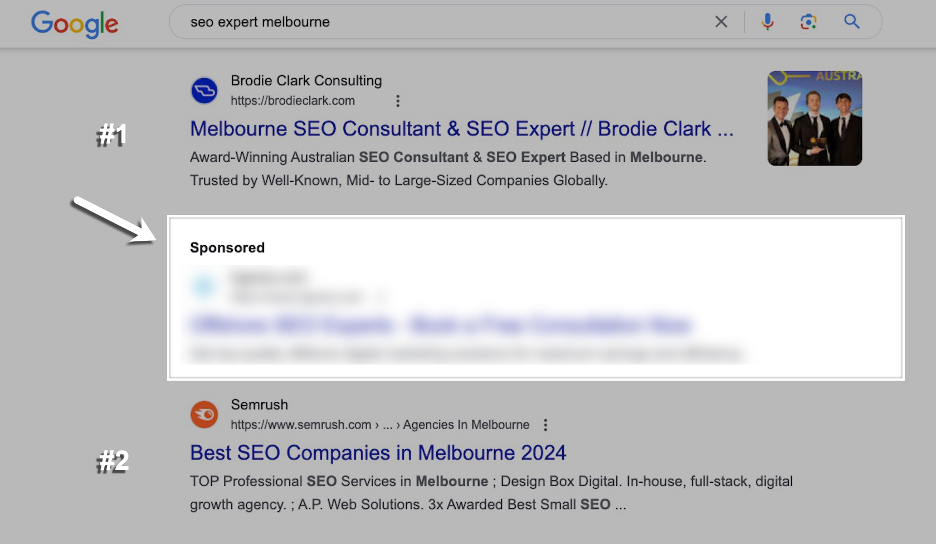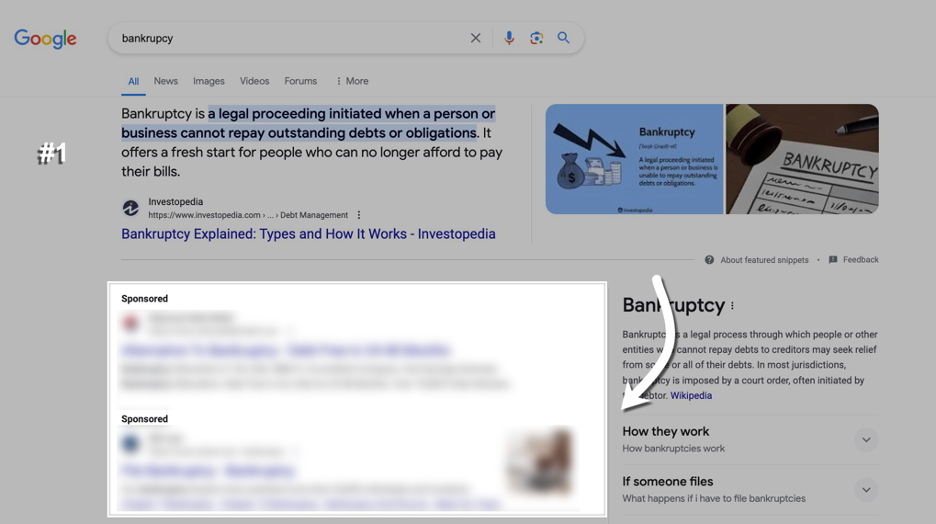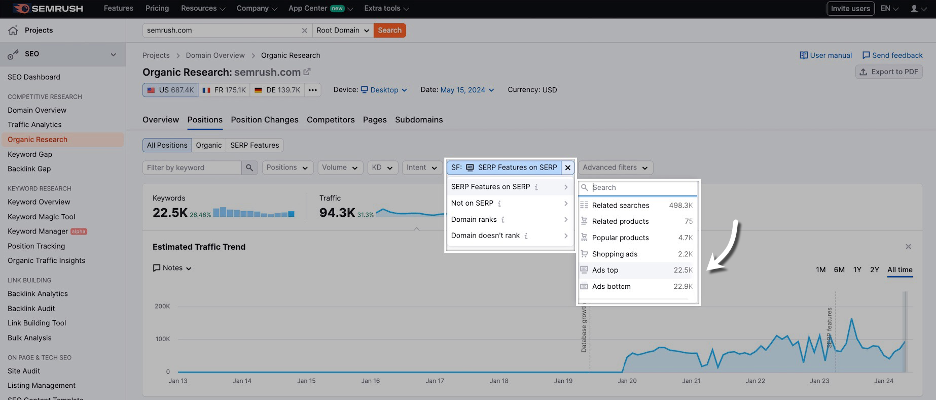

Last updated on

Google has a vested interest in driving users to click on its sponsored ads, but not at the expense of user satisfaction.
However, this balance seems to have shifted in recent years, with Google partaking in actions that have adversely affected user experience.
Traditionally, search engine users were accustomed to seeing ads positioned either at the top or bottom of a Search Engine Results Page (SERP), with organic results occupying the main space or interspersed between the ads. Various search features were also integrated into the mix.
But now, there’s been a shift.
A recent alteration in Google’s documentation reveals that:
“Top ads may appear below the top organic results for certain queries.”
This update highlights the dynamic nature of top ad placement.
This article delves into this change and its repercussions on users and organic search outcomes.
In the lead-up to the change, Google had been experimenting with integrating sponsored ads into organic listings in different ways over a span of 10 months. Below is a timeline outlining the key developments preceding the official rollout.
During its initial phase, this test made its debut in Google’s search results, exclusively appearing on mobile devices. Throughout this preliminary testing stage, the feature was visible to only a small subset of users. Its integration was subtle, particularly on mobile platforms, where it closely resembled an organic listing, potentially leading users to mistake it for one.
During this testing phase, it marked the first instance where the wider SEO community began to observe the emergence of ad labels within organic listings, visible on both mobile and desktop platforms. This testing duration was extended as the launch date approached.
On the specified date, Google’s Ads Liaison made a significant announcement, confirming that the change would be permanent. This announcement was accompanied by the addition of a new definition in the “top ads” documentation. Consequently, users were informed to anticipate a formal transition, wherein ads would be seamlessly integrated with organic results, extending beyond the confines of limited testing.
Now that Google has been blending sponsored ads within organic results for nearly two months, we have a clearer grasp of the scope of the change and the manner in which sponsored ads are being displayed.
According to my findings, there are two prevalent scenarios in which Google is incorporating ads within organic listings.
The typical method involves placing a straightforward advertisement among the top organic search results.
In my experience, it’s typical to see one or two ads grouped together in this scenario. It’s unusual to have more than four consecutive ads.
Take this scenario, for instance:

Here, the sponsored ad technically occupies the second position on the page. Ordinarily, it would have appeared above my content, but in this case, it’s positioned below.
For the Semrush page, its visibility on the SERP remains unaffected whether the ads are above or below. However, for my page, having the ad below provides an advantage in terms of ranking visibility.
The most prevalent method of integrating ads with organic listings is by positioning them directly below a featured snippet.
In such instances, it’s typical to find a complete set of four ads displayed beneath the featured snippet. However, in this particular example, only two ads are visible.

In the past, and still currently, ads would consistently appear directly above the featured snippet. This placement might have been regarded as detrimental to user experience, especially since featured snippets typically provide concise answers to queries directly from the page.
Each of the scenarios outlined in the previous section could be viewed from various perspectives.
The first scenario, where ads are blended within organic results, appears to reflect Google’s aim to stimulate more ad clicks and acclimate users to ads being present at the top, potentially leading users to mistake ads for organic listings.
On the other hand, the second scenario involving featured snippets might be seen differently. Despite ads still being visible within the viewport on desktop, the user’s query is prominently addressed at the top of the search results without ads obstructing the view. This could be interpreted as Google prioritizing user experience by providing quick and direct access to relevant information.
It’s difficult to perceive these changes as detrimental for users or SEO, as Google seems to be enhancing the visibility of organic listings in these scenarios.
Overall, I understand Google’s necessity to prioritize ad revenue through adjustments to ad placement. While there are valid arguments from both perspectives regarding these changes, I see the outcome as relatively neutral for both sides.
Although ads integrated within organic results remain quite uncommon, the utilization of featured snippet placements is more widespread, presenting clear advantages in certain situations.

Although Semrush offers an Advertising Research tool to track ad positions for various queries, I discovered that the data wasn’t collected in a manner enabling comparison of ad position relative to organic listings.
As an alternative, I found that the most effective approach for analysis was to utilize the “Ads top” filter as a SERP feature through Organic Research. This filter locates instances where ads are blended with organic listings.
Here’s where you can find this filter:
Despite its effectiveness, this filtering method doesn’t allow for filtering by URLs for a specific domain; instead, it highlights instances where “top ads” are a SERP feature across the Semrush index.
Through this method, I’ve been able to review historical top ad inclusions since the launch in March and can conclude that ads mixed in with organic results remain exceptionally rare.
In general, considering Google’s current operations, I’m not overly worried about the recent ad placement adjustment from Google.
Although the alteration is official according to Google’s updated documentation, it’s more akin to a trial run. Ads are still predominantly appearing in their usual positions in most cases.
Based on my investigation, I view this change as relatively neutral for both Google users and SEO. If you notice ads blending with organic search results, it’s wise to remain vigilant.
I’ll be closely monitoring this adjustment to ensure that Google doesn’t go overboard with its ad placements.
Google’s recent ad testing has reverted back to using “ad” labeling on mobile instead of “sponsored,” which was the norm until recently.
We can anticipate these sorts of experiments to persist in the future, ensuring that there’s never a dull moment in our industry.
Original news from SearchEngineJournal